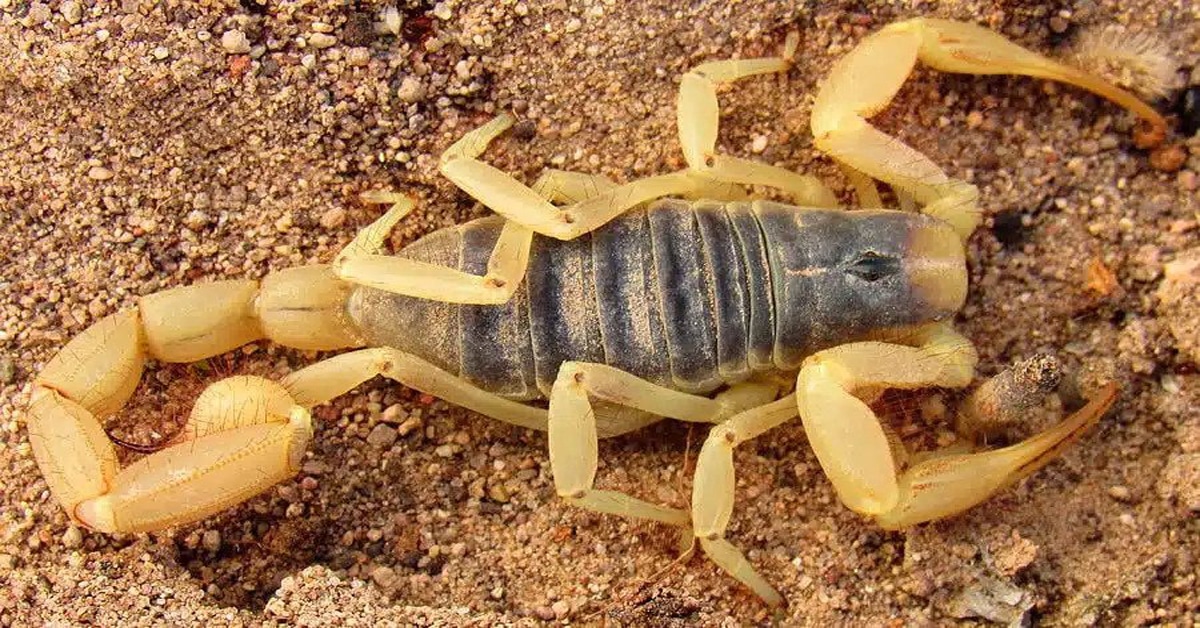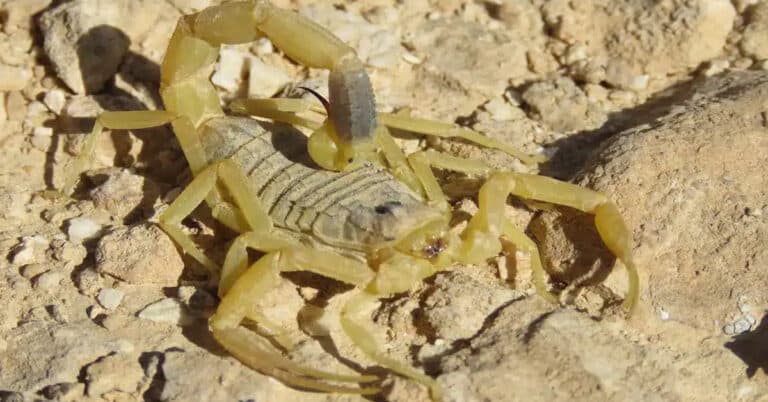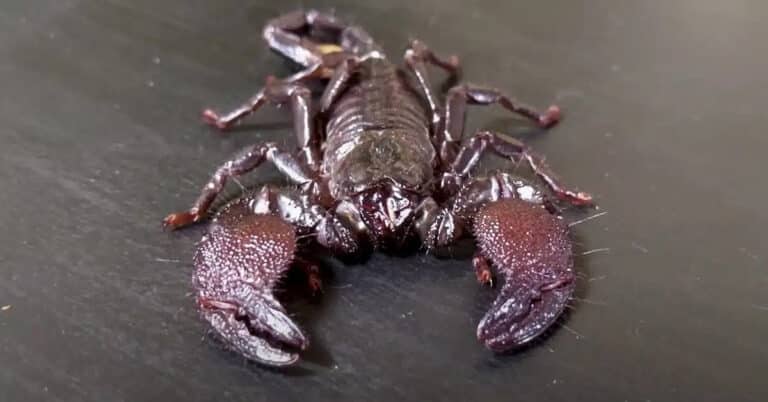Desert Hairy Scorpion: Everything You Need to Know
Scorpions are one of the first animals to have ever evolved on this world, the first of their species evolving around 460 million years ago. They have formed into nearly 2000 different species that still exist today, from Emperor scorpions, Desert Hairy scorpions, and more dangerous species such as Deathstalkers and Indian Red scorpions.
Scorpions evolved in water, some possessing a telson (stinger), and others not possessing a telson. Eventually, less than 20 million years later, scorpions became the first known animal to venture out of the water and make their homes on land.
Should scientists and fossil experts be right, this would make scorpions the oldest land animal in the world. Scorpions were able to do this because they can reserve oxygen in their cells for extended periods of time.
This would be the reason they can live in radioactive climates without suffering any ill affects, and it’s also the reason they can still to this day remain alive under water for up to two days.
Scorpions were quite sizeable when they first came around, the smallest of which reached over a meter in length, unlike the sub-seven inch specimens we see today. Some have even been recorded at over eight feet in length.
These are truly special, extraordinary creatures that have been incredibly successful throughout their near-500 million year reign on this Earth. They’re perhaps the most successful animal species of all-time.
Scorpions are found on every continent aside from Antarctica, making them one of the widest-distributed animals in the world.
Desert Hairy Scorpions
One of the most beautiful scorpion species in the world today happen to inhabit the Southwestern United States in places such as Utah, Nevada, Arizona, New Mexico, and California, largely found in the Sonoran and Mojave deserts, the Giant Desert Hairy Scorpion.
This is an aggressive and active burrowing scorpion that is used to dry and hot climates. Like all scorpions, they’re nocturnal, and the burrows they create can be quite elaborate.
And, Desert Hairy scorpions are the largest of its kind in the states, averaging 5-to-7 inches as adults. This would be the reason you sometimes see them titled as Giant Desert Hairy scorpions. They can be quite sizeable specimens, assuming they live to adulthood of course.
Females are generally the bigger of the two, as they need the extra space to carry young inside of them, while males often times have the bigger pedipalps.
Pedipalps are a pair of modified appendages unique to arachnids.
For instance, scorpion pedipalps have modified into claws, while spiders, such as true spiders, tarantulas, and camel spiders have modified their pedipalps into sensory glands that aid them in feeling what’s in front of and around them.
In a scorpions case, they’re used to clamp down on pray prior to delivering a sting of venom with their telson. Desert Hairy scorpions also have sensory hairs all along their bodies, such as their tail, eight legs, and pedipalps, aiding them in being aware of their surroundings.
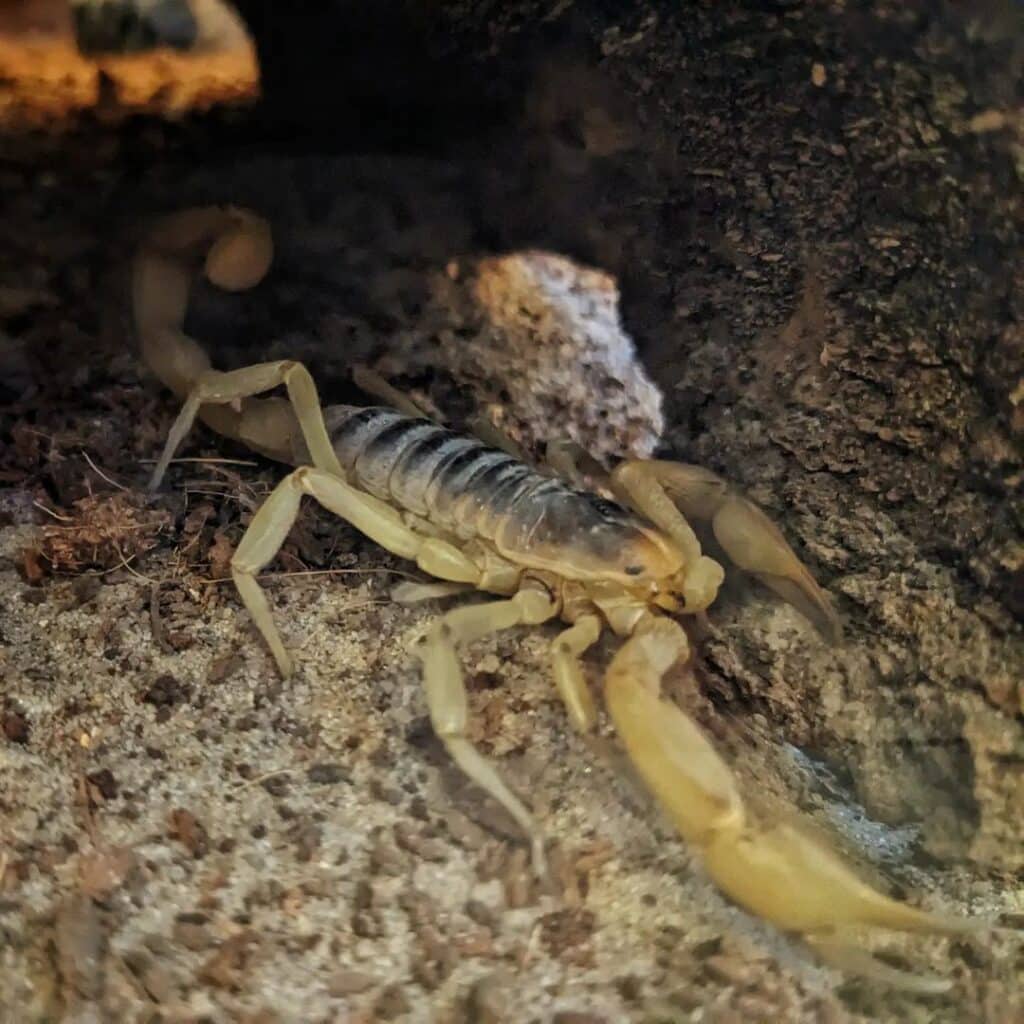
Venom
Out of nearly 2000 scorpion species across the globe, only about 25 possess a potent enough venom to kill a human.
The venom a Desert Hairy scorpion possesses isn’t considered dangerous to humans, unless of course you have an allergic reaction to the venom. They’re slightly more venomous than that of an Emperor scorpion, but is still no more dangerous than an average bee sting to most.
And yes, all scorpions are venomous.
It does hurt, but you’ll more than likely be fine. It’s the claws you’ve really got to worry about with this species.
Coyote Peterson actually did an experiment on scorpion stings (pictured above) on his YouTube channel Brave Wilderness. Be sure to check that out, he purposely gets stung by all sorts of unnerving animals just for the sake of explaining what it’s like.
Feeding and Diet
It’s quite fascinating to see Desert Hairy scorpions kill and eat pray; once they’ve caught the insect they’ll be feeding on, a sting from their telson will usually immobilize their pray, making it easier for them to hold onto whilst tearing through it with their chelicerae.
Chelicerae are the two pairs of mouthpart appendages they use to dissect their pray with.
This can be incredibly intriguing to witness. Even if they’re buried in a shallow burrow, they can still deliver a sting by propelling their telson sideways into the pray, rather than bringing it over the top as most of us are used to seeing.
They’re very intuitive little specimens.
Most all scorpions, including Desert Hairy’s, feed on ground-dwelling insects such as crickets and roaches of many kinds, grasshoppers, a wide variety of worms and grubs, and sometimes even small rodents and lizards.
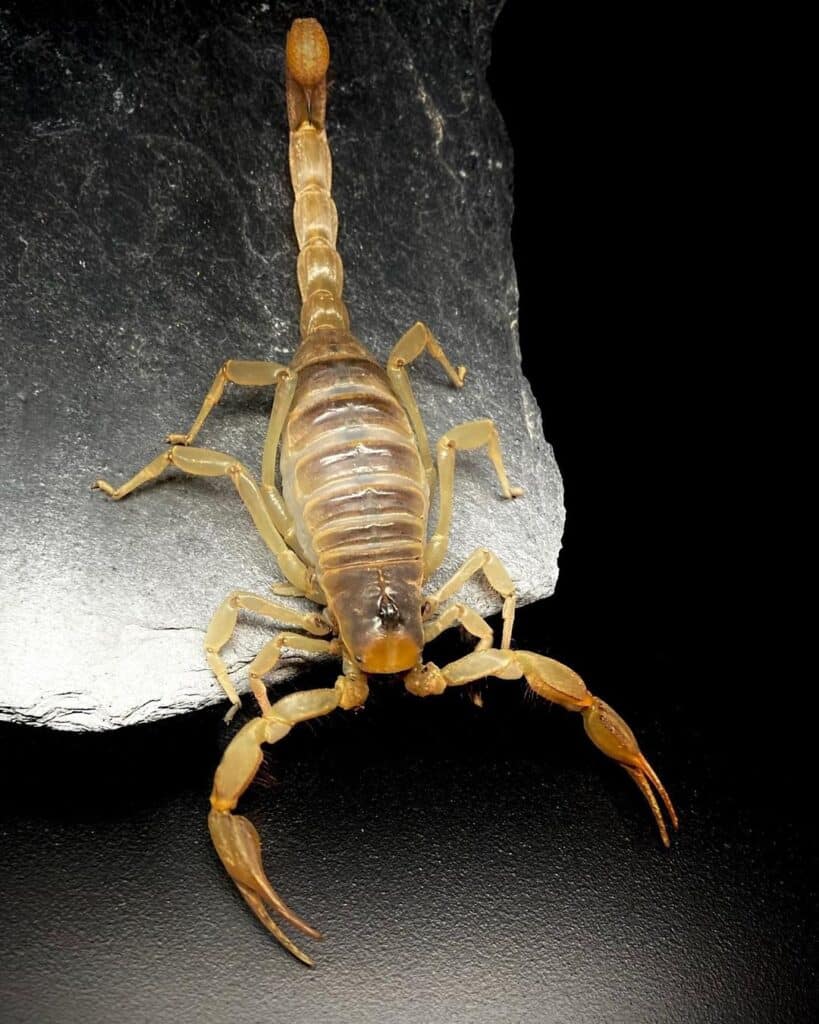
Molting
Scorpions, like all arachnids, molt their exoskeletons as they grow. This involves shedding their hard layer of outer-skin in order to grow bigger.
They will not feed for roughly a week leading up to this, because if they’re already big enough to molt, growing bigger prior to doing so will make it more difficult for them to later climb out of their faces.
Scorpions will also not feed for days following their molt, as their new layer of exoskeleton will be soft and needs a little time to harden.
If you have a Desert Hairy scorpion that may appear to be dead, not moving, or struggling to move, it’s likely just going through a molt, and will generally need less than 24 hours to do so.
If you notice your scorpion is going through a molt, especially any desert species, it would be wise to spray their enclosure with water, preferably over the heating pad.
Do not soak their enclosure or substrate, but simply raise the humidity to roughly 50-60% to aid them in a successful molt. Their environment being too dry (like they’re used to being from the desert) can make it nearly impossible for them to climb out.
But, do not make a habit of this. When Desert Hairy scorpions live inside of an enclosure that’s too humid, it will give them respiratory illness and they can easily die from this.
Your Desert Hairy scorpions enclosure should regularly be below 30% humidity.
Desert Hairy Scorpion Care
Caring for your Desert Hairy scorpion comes at a low cost, and they’re easy to take care of, making them a perfect choice for exotic animal lovers.
The scorpion itself will cost you around $30, but you may have to pay for your source to ship it, as you will not find them in pet stores. You may however find them at some reptile expos if you’re lucky.
Their heating should be anywhere from 80-to-just-over-90 degrees Fahrenheit (26-33 Celsius) during the day with a 10-to-15 degree drop at night (70-78 Fahrenheit, 21-25 Celsius).
This can be achieved with a heating pad that you simply turn off at night.
It doesn’t have to be exact, these are incredibly durable, hardy creatures, but it’s favorable to stick to that rule of thumb around that said range.
Be sure to know the heat of their substrate at all times, which can be best achieved with a thermometer. If their substrate gets too hot, the scorpion will burrow deeper and deeper in order to cool down.
If you keep a heating pad under their enclosure, as most do, this can be deadly for your scorpion, as they will often times not understand until it’s too late.
These incredible creatures are like vampires; the sun, and excessive heat will cook them alive, thus the reason they’re nocturnal. It is very important to understand this so your scorpions substrate will be cooler than the air in the tank, should the air in the tank be on the hotter side.
It’s actually quite simple to keep these scorpions alive and healthy, assuming they’re captive bred of course.
To ensure you get a captive bred specimen, be sure to check out BackWaterReptiles.com, they specialize in captive breeding all their animals.

DO NOT order them from UnderGroundReptiles.com!
UnderGroundReptiles field collects (wild catches) over 90% of the animals they sell, making it very difficult for wild populations to thrive, and over half of their reviews (not posted on their site) are negative, with buyers claiming their animals died within a week of receiving them.
I myself have bought two animals from them, a Blonde Desert Hairy scorpion and a Stripe Tailed scorpion, and within two months, both were dead. I have a number of other scorpions I purchased from BackWaterReptiles and every last one of them is still thriving.
Do not help create the incentive for them to continue doing this.
What You’ll Need
If you’re interested in purchasing a Desert Hairy scorpion, there are of course a few things you’ll need to purchase and do prior to your receiving your pet.
Firstly, you’ll need a 10 gallon enclosure. You can go bigger if you so choose, but assuming you purchase a juvenile-to-adult, a 10 gallon tank is suitable.
You’ll also need a clay burrowing substrate, hides, a moonlight, and a dome for the moonlight. Any of the options seen below will work just fine.

For the substrate, Excavator Clay Burrowing Substrate is your best bet; you’ll need to mix it with water (instructions on bag) and make sure you get all of the clumps out until it’s mixed thoroughly. A kitchen mixer will work well for this, or you could just use your hands.
Once it’s at the correct consistency, you want to dump it into the enclosure and pat it down as thick as you can. Some people mix sand into the substrate mixture, but I’ve never done that successfully.
When mixing sand into the clay substrate, often times the tunnels the scorpion will build end up collapsing. If you only use the clay substrate, and if you pack it down firmly enough, the tunnel(s) they create will last months.
It will be quite hard once it dries, but do not worry. They will be able to dig through it. You will also need to wait at least a week to put your scorpion in the enclosure after doing this, as the humidity will be far too high immediately following.
Wait until the humidity drops to around 20-30% and then put your scorpion in its new home.
You could either put a water dish in the enclosure with them, or you could use sphagnum moss to give them water with.
Should you use a water dish, it’s a good idea to fill it with rocks in order to keep your scorpion from submerging itself, and should you use moss, form it into a tight ball with your hand, then simply soak it with spring water and place it in a corner of your enclosure.
Desert Hairy scorpions are not only violent little killers, but they’re also artists; the tunnels they create can be quite incredible and elaborate.
But, even so, they still need at least one hide in their enclosure, as it takes time for them to make homes of their own. Sometimes they’ll get right to work on building their tunnel that night you put them into their new home, and other times it may take them a couple weeks to begin digging it.
Being night-dwellers, this is the time they will get to work with their digging and forming.
Also, we mentioned you’ll need a moonlight for them. This is because they get the same nutrients from the moon that we humans get from the sun.
Most all desert scorpions need a moonlight, whereas forest species do not. This would be due to all of the forestation blocking the moonlight from reaching the scorpions on the forest floor, forcing them to evolve without the need for it.
Deserts are wide open ranges, and you’ll almost always find them out of their burrows soaking up the moonlight at night time.
If you enjoyed this piece, be sure to check out our article on Emperor Scorpions as well, and feel free to share this on social media!

I started writing in the fourth quarter of 2018. I wrote solely about MMA and boxing up until October of 2022, where I began writing about animals; primarily dangerous, venomous species. They’ve always fascinated me. Considering, my goal is to make a living by teaching people about these wonderful creatures. You can check out my Facebook page, where every article I’ve ever written currently sits, or you can check out my Twitter page, where I’ve shared all of my animal pieces to date.

